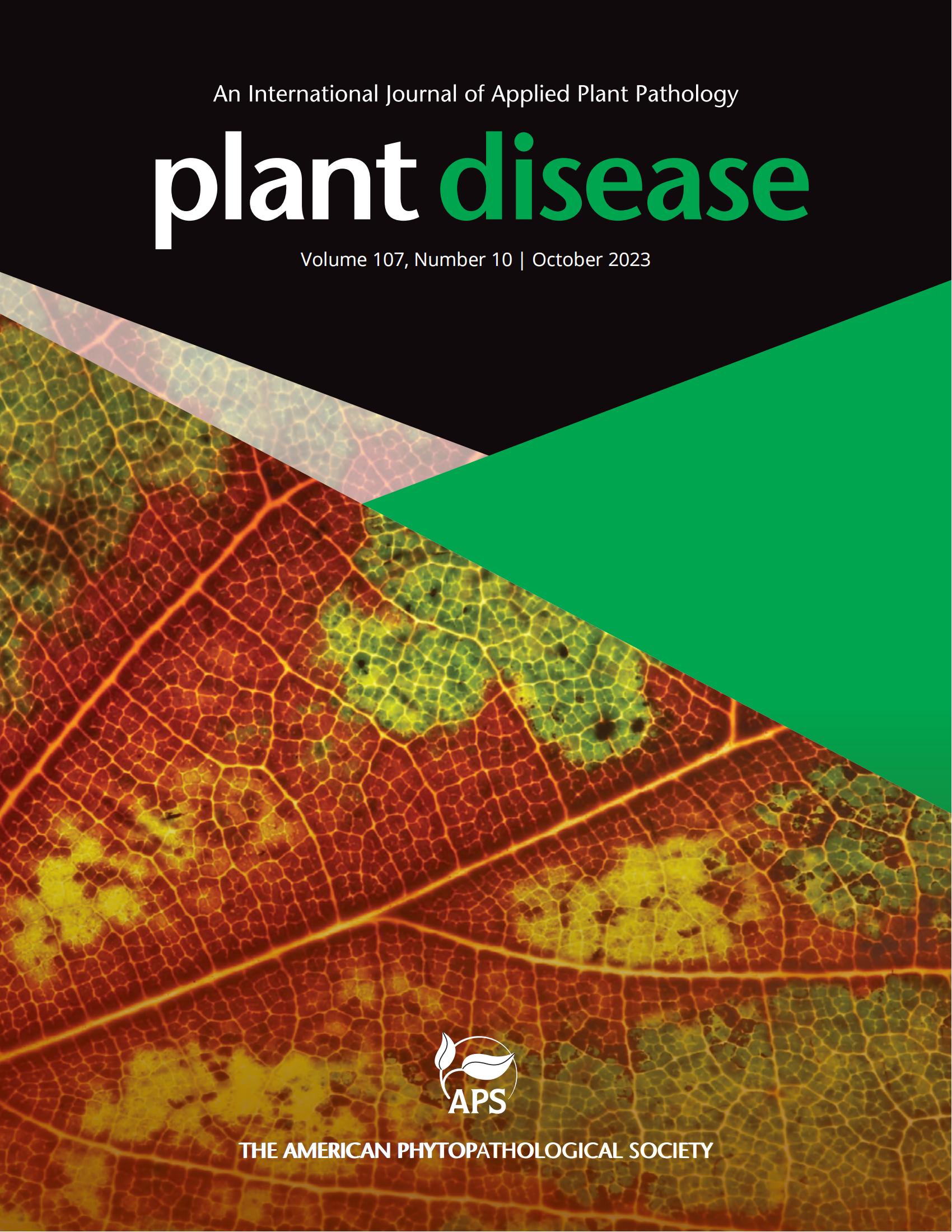日本首次报告由 Pyrenophora avenicola(venicola芘)引起的 Avena strigosa 叶枯病。
摘要
黑燕麦(Avena strigosa Schreb.)在温带地区被用作谷类作物、饲料作物或绿肥。在日本,它主要在北海道岛种植,由于初期生长旺盛并能抑制植物病原线虫的繁殖(Uesugi 等人,2018 年),其使用量最近正在增加。2021 年 11 月,在北广岛市(N43°0,E141°31)种植的草地上发现了叶斑病和枯萎病。最初,叶片上形成黑褐色纺锤形或椭圆形病斑,约 3 至 5 × 1 至 2 毫米,病斑扩大,周围形成黄褐色晕圈,最终导致叶枯病(图 1),受害叶面积达 5-10%,因品种而异。切除病斑,表面消毒,在近紫外光下放在水琼脂中培养。从病斑中获得了三个单孢类拟火棘真菌分离物,并以 MAFF511692、511693 和 511694 存入日本 NIAS 基因库(https://www.gene.affrc.go.jp/index_en.php)。按照 Marin-Felix 等人 2019 年的描述,对分离物的核糖体 RNA 基因(rDNA)及其内部转录间隔(ITS)序列和 gpd 序列进行了分析。分离物的 rDNA-ITS 序列(GenBank 编号:LC769170、LC769171 和 LC769172)与从枳种子中分离出的枳 Pyrenophora avenicola 前型菌株(MK539972)的序列相符。gpd 的序列(登录号:LC795722、LC795723 和 LC795724)与前型菌株(MK540180)的序列十分吻合。分离株的分生孢子梗有隔,直或曲折,淡褐色至橄榄褐色,81.4-125.7 × 4.2-6.5(平均 106.4×5.7µm,n=50) µm,有透明的无性菌丝(图 2)。分生孢子略有瘤状,圆柱形到倒棍形,淡褐色到橄榄褐色, 42.2 到 78.5 × 9.0 到 13.3 µm (平均值 56.9 × 10.4 µm,n=50),2 到 7 个分隔。该描述与 P. avenicolai 的原始描述(Marin-Felix 等,2019 年)以及中国报道的莜麦叶斑病病原(陈等,2022 年)相重叠。根据形态学和分子系统学分析,该真菌被鉴定为 P. avenicola。为了产生接种体,分离菌 MAFF511692 在 25°C 的 V8 果汁琼脂上,在近紫外光下培养 7 天。在温室中栽培了约 14 天,然后在五叶期用分生孢子悬浮液(104 个分生孢子/毫升)雾化接种了 A. strigosa 的'Soil saver'、'New oats'(Kaneko 种子公司)和 A. sativa 的'New almighty'(雪牌种子公司)各五株植物。每个栽培品种的五株植株喷洒灭菌蒸馏水作为对照。接种的植株用塑料袋覆盖,在 25°C 下放置 24 小时。5 天后,所有接种的糙芒草(图 3)和荠菜栽培品种的植株叶片上都出现了黑褐色的椭圆形病斑,这表明真菌对莜麦的品种和栽培品种具有广泛的致病性。可能由于温室环境中的压力较小,没有观察到光晕。对照组仍无症状。产生的病斑按上述方法进行培养,根据形态重新分离出的真菌被鉴定为venicola(venicola)真菌,证实了科赫假说。据我们所知,这是日本首次报道由 P. avenicola 在黑燕麦上引起的叶枯病。Black oat (Avena strigosa Schreb.) is used as a cereal crop, forage crop or green manure in temperate regions. In Japan, it is mainly cultivated in Hokkaido island and, because of the vigorous initial growth and ability to suppress the proliferation of plant pathogenic nematodes (Uesugi et al. 2018), its use is recently increasing. In November 2021, a leaf spot and blight disease was observed in the grass cultivated in Kitahiroshima city (N43°0, E141°31). At first, blackish brown spindle-shaped or elliptical lesions, about 3 to 5 × 1 to 2 mm were formed on leaves, and they expanded by forming yellowish-brown halos around them, eventually resulting in leaf blight later on (Fig.1), damaging 5-10 % of leaf area, varied by cultivar. The lesions were excised, surface-sterilized, and incubated on water agar under near-UV light. Three single-spore isolates of Pyrenophora-like fungus were obtained from the lesions and deposited at the NIAS Genebank, Japan (https://www.gene.affrc.go.jp/index_en.php) as MAFF511692, 511693 and 511694. The sequences of ribosomal RNA gene (rDNA) and its internal transcribed spacer (ITS), and the gpd sequences of the isolates were analyzed as described by Marin-Felix et al. 2019. The rDNA-ITS sequences (GenBank accession no. LC769170, LC769171 and LC769172) of the isolates matched with that of the ex-type strain of Pyrenophora avenicola (MK539972) isolated from Avena seed. The sequences of the gpd (accession no. LC795722, LC795723 and LC795724) matched well with that of the ex-type strain (MK540180). Conidiophores of the isolates were septate, straight or flexuous, pale brown to olivaceous brown, 81.4 to 125.7 × 4.2 to 6.5 (ave. 106.4×5.7µm, n=50) µm, with hyaline vegetative hyphae (Fig.2). Conidia were slightly verrucose, cylindrical to obclavate, pale brown to olivaceous brown, 42.2 to 78.5 × 9.0 to 13.3 µm (ave. 56.9 ×10.4µm, n =50) and 2 to 7 distoseptate. This description overlap with the original description of P. avenicolai (Marin-Felix et al. 2019) and the leaf spot pathogen of Avena sativa reported in China (Chen et al. 2022). The fungus was identified as P. avenicola on the basis of morphology and molecular phylogenetic analysis. To produce inoculum, the isolate MAFF511692 was grown on V8 juice agar at 25°C under near-UV light for 7 days. Five plants each of cv. 'Soil saver', 'New oats' of A. strigosa (Kaneko seeds co.) and 'New almighty' of A. sativa (Snow brand seed co.) were grown in a greenhouse for approximately 14 days and then inoculated by atomizing them with the conidial suspension (104 conidia/ml) at the five-leaf stage. Five plants of each cultivar sprayed with sterilized distilled water served as the control. Inoculated plants were covered with plastic bags for 24 h at 25°C. After 5 days, blackish brown elliptical lesions developed on the leaves of all inoculated plants of both cultivars of A. strigosa (Fig. 3) and A. sativa, implying broad pathogenicity of the fungus to species and cultivars of Avena plants. Halo was not observed, maybe due to fewer stress in the greenhouse environment. Controls remained asymptomatic. The produced lesions were incubated as described above and the reisolated fungus was identified as P. avenicola based on the morphology, confirming Koch's postulates. To our knowledge, this is the first report of leaf blight caused by P. avenicola on black oat in Japan.

 求助内容:
求助内容: 应助结果提醒方式:
应助结果提醒方式:


